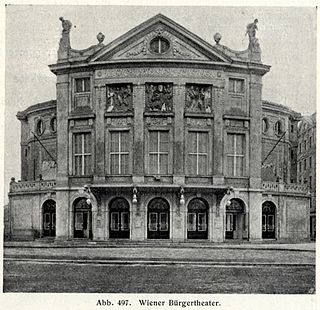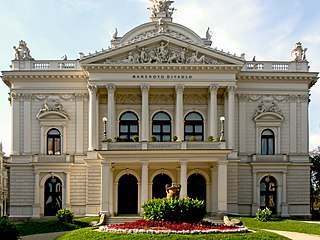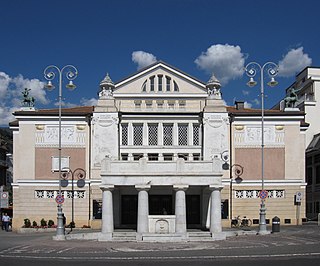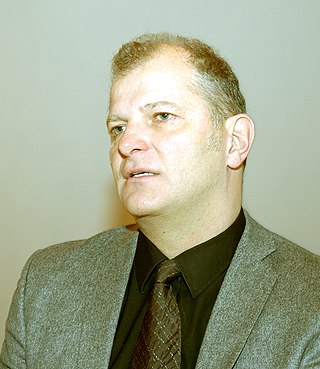
Stadttheater Klagenfurt is the municipal theatre in Klagenfurt, the capital of Carinthia in Austria. Its present house was designed by the Viennese architecture office Fellner & Helmer, and completed in 1910.

Stadttheater Klagenfurt is the municipal theatre in Klagenfurt, the capital of Carinthia in Austria. Its present house was designed by the Viennese architecture office Fellner & Helmer, and completed in 1910.

The first theatre in Klagenfurt was installed between 1605 and 1620 as Ballhaus for the aristocracy. Italian troupes appeared, on their way from Venice to Vienna. At the end of the 18th century, the theatre was occasionally opened also for intellectuals, and military and civil officials. In 1811, the wooden structure was rebuilt in stone, called now Altes Theater (Old Theatre).
When it deteriorated, a new house was designed by the Viennese architecture office Fellner & Helmer, who had already built the very similar theatres in Gießen and Gablonz, in 1906 and 1907. [1] Building began in 1908 and was completed in 1910. The house was opened on the occasion of the 60th jubilee of Franz Joseph I of Austria and therefore named "Kaiser Franz Joseph I. Jubiläumstheater".
In the 1960s, the house was renovated, and again from 1996 to 1998 after designs by Günther Domenig.
The Stadttheater Klagenfurt was awarded the Nestroy Theatre Prize in different categories in 2003, 2006 and 2011. Artists who received the prize and worked for this theatre have included Martin Kušej, Bernd Liepold-Mosser , Michael Maertens, Michael Schottenberg and Martin Zehetgruber .

Baden, unofficially distinguished from other Badens as Baden bei Wien, is a spa town in Austria. It serves as the capital of Baden District in the state of Lower Austria. Located about 26 km (16 mi) south of Vienna, the municipality consists of cadastral areas Baden, Braiten, Gamingerhof, Leesdorf, Mitterberg, Rauhenstein, and Weikersdorf.
The year 1891 in architecture involved some significant architectural events and new buildings.

The Burgtheater, originally known as K.K. Theater an der Burg, then until 1918 as the K.K. Hofburgtheater, is the national theater of Austria in Vienna. It is the most important German-language theater and one of the most important theatres in the world. The Burgtheater was opened in 1741 and has become known as die Burg by the Viennese population; its theater company has created a traditional style and speech typical of Burgtheater performances.

The Croatian National Theatre in Zagreb, commonly referred to as HNK Zagreb, is a theatre, opera and ballet house located in Zagreb.

The Zurich Opera House is an opera house in the Swiss city of Zurich. Located at the Sechseläutenplatz, it has been the home of the Zurich Opera since 1891, and also houses the Bernhard-Theater Zürich. It is also home to Ballett Zürich.

Fellner & Helmer was an architecture studio founded in 1873 by Austrian architects Ferdinand Fellner and Hermann Helmer.

The Solomiya Krushelnytska Lviv State Academic Theatre of Opera and Ballet or Lviv Opera is an opera house located in Lviv, Ukraine's largest western city and one of its cultural centres. Originally built on former marshland of the submerged Poltva River, the Lviv Opera now located on Liberty Avenue, the tree-lined centrepiece of Lviv's historic Old City, a UNESCO World Heritage Site located in the city's Halych district.

The Bürgertheater was a theatre in Vienna.

The Deutsches Schauspielhaus, sometimes referred to as the Hamburg Schauspielhaus or Hamburg Theatre, is a theatre in the St. Georg quarter of the city of Hamburg, Germany

Mahen Theatre is a Czech theatre situated in the city of Brno. Mahen Theatre, built as German Deutsches Stadttheater in 1882, was one of the first public buildings in the world lit entirely by electric light. It was built in a combination of Neo-renaissance, Neo-baroque and Neoclassical architectural styles.

The Stadttheater Meran or Teatro Civico di Merano is the civic theatre of the town of Merano in South Tyrol, northern Italy.

Martin Kušej is an Austrian theatre and opera director, and is director of the Burgtheater Vienna. According to German news magazine Focus, Kušej belongs to the ten most important theatre directors who have emerged in the German-speaking world since the millennium. He is considered one of the most important directors working today, acclaimed for his dark and incisive productions.

Stadttheater Fürth is a theatre in Fürth, Bavaria, Germany. It was designed by the Viennese architecture office Fellner & Helmer, and completed in 1902.

Theodor Friedl was an Austrian sculptor.

The Theater Gießen, official name Stadttheater Gießen, is a theatre in Gießen, Germany, a cultural center for the university city and the region. The main building was designed in Neo-classical style with influences of Jugendstil by architects Fellner & Helmer and completed in 1906. It has two stages, seats around 700 visitors and presents opera, musical, operetta, plays and modern dance theatre.

The German State Theatre Timișoara is a publicly funded German-language theatre company in Timișoara, Romania, where a German-language theatre was first mentioned in 1753. The new theatre opened in 1875, but closed again in 1899 as a result of increasing Magyarization in the then Kingdom of Hungary. The ceremonial reopening of the German State Theatre Timișoara took place on 27 June 1953. The German State Theatre is located in the right wing of the Palace of Culture with entrance from Alba Iulia Street. It has a 100-seat theatre hall that it shares with the Hungarian State Theatre.
Stefan Großmann was a Viennese writer who became one of the most prominent left-wing liberal journalists of his generation. He was the founder and during its first seven years the producer of the respected political weekly journal Das Tage-Buch.
Guido Mancusi is an Austrian-Italian conductor and composer.

The Ronacher theater, originally Etablissement Ronacher, is a theater in the Innere Stadt district of Vienna, Austria.

Olha Kobylianska Chernivtsi Academic Regional Ukrainian Music and Drama Theatre, also known as Kobylianska Drama Theatre, is a drama and music theatre located in Chernivtsi, Ukraine. The current building of the theater is a neobaroque architectural monument of national significance, built in 1905 by an Austrian architectural bureau Fellner & Helmer.